Stormwater
Stormwater, also spelled storm water, is water that originates from rain, including snow and ice melt. Stormwater can soak into the soil (infiltrate), be stored on the land surface in ponds and puddles, evaporate, or runoff. Most runoff is conveyed directly to nearby streams, rivers, or other water bodies (surface water) without treatment.
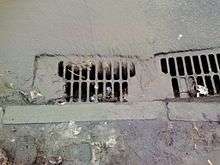
In natural landscapes, such as forests, soil absorbs much of the stormwater. Plants also reduce stormwater by improving infiltration, intercepting precipitation as it falls, and by taking up water through their roots. In developed environments, unmanaged stormwater can create two major issues: one related to the volume and timing of runoff (flooding) and the other related to potential contaminants the water is carrying (water pollution).
Stormwater is also an important resource as human population and demand for water grow, particularly in arid and drought-prone climates. Stormwater harvesting techniques and purification could potentially make some urban environments self-sustaining in terms of water.
Stormwater pollution
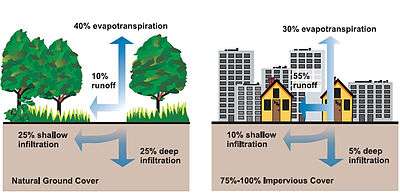
With less vegetation and more impervious surfaces (parking lots, roads, buildings, compacted soil), developed areas allow less rain to infiltrate into the ground, and more runoff is generated than in the undeveloped condition. Additionally, conveyances such as ditches and storm sewers quickly transport runoff away from commercial and residential areas into nearby water bodies. This greatly increases the volume of water in waterways and the discharge of those waterways, leading to erosion and flooding. Because the water is flushed out of the watershed during the storm event, little infiltrates the soil, replenishes groundwater, or supplies stream baseflow in dry weather.[1]
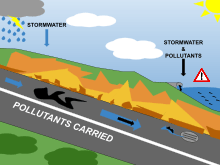
A first flush is the initial runoff of a rainstorm. During this phase, polluted water entering storm drains in areas with high proportions of impervious surfaces is typically more concentrated compared to the remainder of the storm. Consequently, these high concentrations of urban runoff result in high levels of pollutants discharged from storm sewers to surface waters.[2][3]:216
Daily human activities result in deposition of pollutants on roads, lawns, roofs, farm fields, and other land surfaces. Such pollutants include sediment, nutrients, bacteria, pesticides, metals, and petroleum byproducts.[4] When it rains or there is irrigation, water runs off and ultimately makes its way to a river, lake, or the ocean. While there is some attenuation of these pollutants before entering receiving waters, polluted runoff results in large enough quantities of pollutants to impair receiving waters.[5]
Stormwater runoff as a source of pollution
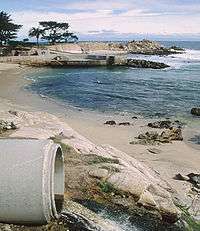
In addition to the pollutants carried in stormwater runoff, urban runoff is being recognized as a cause of pollution in its own right. In natural catchments (watersheds) surface runoff entering waterways is a relatively rare event, occurring only a few times each year and generally after larger storm events. Before development occurred most rainfall soaked into the ground and contributed to groundwater recharge or was recycled into the atmosphere by vegetation through evapotranspiration.
Modern drainage systems, which collect runoff from impervious surfaces (e.g., roofs and roads), ensure that water is efficiently conveyed to waterways through pipe networks, meaning that even small storm events result in increased waterway flows.
In addition to delivering higher pollutants from the urban catchment, increased stormwater flow can lead to stream erosion, encourage weed invasion, and alter natural flow regimes. Native species often rely on such flow regimes for spawning, juvenile development, and migration.
In some areas, especially along the U.S. coast, polluted runoff from roads and highways may be the largest source of water pollution. For example, about 75 percent of the toxic chemicals getting to Seattle, Washington's Puget Sound are carried by stormwater that runs off paved roads and driveways, rooftops, yards, and other developed land.[6]
For Class V stormwater injection wells [7] the U.S. Environmental Protection Agency reports “the contaminants that have been observed above drinking water standards or health advisory limits in storm water drainage well injectate are aluminum, antimony, arsenic, beryllium, cadmium, chloride, chromium, color, copper, cyanide, iron, lead, manganese, mercury, nickel, nitrate, pH, selenium, TDS, turbidity, zinc, benzene, benzo(a)pyrene, bis(2-ethylhexyl) phtlalate, chlordane, dichloromethane, fecal coliforms, methyl-tertbutyl- ether, pentachlorophenol, tetrachloroethylene, and trichloroethylene.”[8] The U.S. Geological Survey (USGS) reports “Many of the contaminants normally associated with runoff from the Nation's highways have the potential for biological effects. ... Highway-runoff contaminants of particular interest throughout the United States include deicers, nutrients, metals, industrial/urban-organic chemicals, sediment, and agricultural chemicals from industrial, commercial, residential, agricultural, and highway sources.” [9]:3 In addition to the problem of chemical contaminants in stormwater, this USGS report also identifies problems of physical habitat disturbance that Best Management Practices (BMPs) do not eliminate, “Some of the most substantial biological changes caused by development are directly or indirectly related to altered hydrology. Despite efforts to use BMPs to attenuate the hydrologic effects of development, increased peak flows and more flashy runoff will cause physical modifications to the channel shape, bed substrate, and banks of receiving waters, with corresponding effects on aquatic habitat and biota. Loss of forest canopy, increases in paved area, and shallow and(or) muddy detention areas also may cause thermal pollution problems, which can exacerbate chemical stressors on aquatic organisms in receiving waters.” [9]:6 U.S. Congress prohibits Class V stormwater wells to be authorized by permit or by rule where they endanger drinking water sources.[10]
Urban flooding
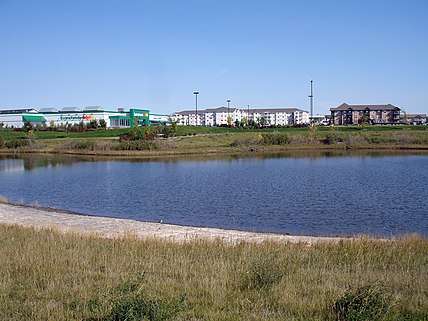
Stormwater is a major cause of urban flooding. Urban flooding is the inundation of land or property in a built-up environment caused by stormwater overwhelming the capacity of drainage systems, such as storm sewers. Although triggered by single events such as flash flooding or snow melt, urban flooding is a condition, characterized by its repetitive, costly and systemic impacts on communities. In areas susceptible to urban flooding, backwater valves and other infrastructure may be installed to mitigate losses.
Where properties are built with basements, urban flooding is the primary cause of basement and sewer backups. Although the number of casualties from urban flooding is usually limited, the economic, social and environmental consequences can be considerable: in addition to direct damage to property and infrastructure (highways, utilities and services), chronically wet houses are linked to an increase in respiratory problems and other illnesses.[11] Sewer backups are often from the sanitary sewer system, which takes on some storm water as a result of Infiltration/Inflow.
Urban flooding has significant economic implications. In the U.S., industry experts estimate that wet basements can lower property values by 10 to 25 percent and are cited among the top reasons for not purchasing a home.[12] According to the Federal Emergency Management Agency almost 40 percent of small businesses never reopen their doors following a flooding disaster.[13] In the UK, urban flooding is estimated to cost £270 million a year (as of 2007) in England and Wales; 80,000 homes are at risk.[14]
A study of Cook County, Illinois, identified 177,000 property damage insurance claims made across 96 percent of the county’s ZIP codes over a five-year period from 2007 to 2011. This is the equivalent of one in six properties in the County making a claim. Average payouts per claim were $3,733 across all types of claims, with total claims amounting to $660 million over the five years examined.[15]
An example of an urban flooding control project is the Brays Bayou Greenway Framework in Houston, Texas. Brays Bayou and its tributaries drain a watershed of approximately 88,000 acres south of downtown Houston. The federally-funded improvement project created a short-term solution by improving the bayou's drainage capacity, and identified a broad set of potential recreation and open space opportunities along the 35 miles of the bayou and tributaries.[16]
Stormwater creation of sinkhole collapses
An example of urban stormwater creating a sinkhole collapse is the February 25, 2002 Dishman Lane collapse in Bowling Green, Kentucky where a sinkhole suddenly dropped the road under four traveling vehicles. The nine-month repair of the Dishman Lane collapse cost a million dollars but there remains the potential for future problems.[17]
In undisturbed areas with natural subsurface (karst) drainage, soil and rock fragments choke karst openings thereby being a self-limitation to the growth of openings.[18]:189–190, 196 The undisturbed karst drainage system becomes balanced with the climate so it can drain the water produced by most storms. However, problems occur when the landscape is altered by urban development.[19]:28 In urban areas with natural subsurface (karst) drainage there are no surface streams for the increased stormwater from impervious surfaces such as roofs, parking lots, and streets to runoff into. Instead, the stormwater enters the subsurface drainage system by moving down through the ground. When the subsurface water flow becomes great enough to transport soil and rock fragments, the karst openings grow rapidly.[18]:190 Where karst openings are roofed by supportive (competent) limestone, there frequently is no surface warning that an opening has grown so large it will suddenly collapse catastrophically.[18]:198 Therefore, land use planning for new development needs to avoid karst areas.[19]:37–38 Ultimately taxpayers end up paying the costs for poor land use decisions.
Stormwater management
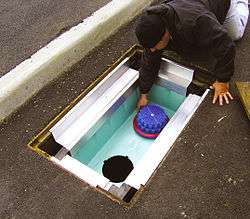
Managing the quantity and quality of stormwater is termed, "Stormwater Management."[20] The term Best Management Practice (BMP) or stormwater control measure (SCM) is often used to refer to both structural or engineered control devices and systems (e.g. retention ponds) to treat or store polluted stormwater, as well as operational or procedural practices (e.g. street sweeping).[21] Stormwater management includes both technical and institutional aspects.[22]
Technical aspects
- control of flooding and erosion;
- control of hazardous materials to prevent release of pollutants into the environment (source control);
- planning and construction of stormwater systems so contaminants are removed before they pollute surface waters or groundwater resources;
- acquisition and protection of natural waterways or rehabilitation;
- building nature-based solutions such as ponds, swales, constructed wetlands or green infrastructure solutions to work with existing or "hard" drainage structures, such as pipes and concrete channels (constructed wetlands built for stormwater treatment can also serve as habitat for plants, amphibians and fish)
Institutional and policy aspects
- development of funding approaches to stormwater programs potentially including stormwater user fees and the creation of a stormwater utility;
- development of long-term asset management programs to repair and replace aging infrastructure;
- revision of current stormwater regulations to address comprehensive stormwater needs;
- enhancement and enforcement of existing ordinances to make sure property owners consider the effects of stormwater before, during and after development of their land;
- education of a community about how its actions affect water quality, and about what it can do to improve water quality.
Integrated water management
Integrated water management (IWM) of stormwater has the potential to address many of the issues affecting the health of waterways and water supply challenges facing the modern urban city. IWM is often associated with green infrastructure when considered in the design process. Professionals in their respective fields, such as urban planners, architects, landscape architects, interior designers, and engineers, often consider integrated water management as a foundation of the design process.
Also known as low impact development (LID)[23] in the United States, or Water Sensitive Urban Design (WSUD)[24] in Australia, IWM has the potential to improve runoff quality, reduce the risk and impact of flooding and deliver an additional water resource to augment potable supply.
The development of the modern city often results in increased demands for water supply due to population growth, while at the same time altered runoff predicted by climate change has the potential to increase the volume of stormwater that can contribute to drainage and flooding problems. IWM offers several techniques, including stormwater harvest (to reduce the amount of water that can cause flooding), infiltration (to restore the natural recharge of groundwater), biofiltration or bioretention (e.g., rain gardens), to store and treat runoff and release it at a controlled rate to reduce impact on streams and wetland treatments (to store and control runoff rates and provide habitat in urban areas).
There are many ways of achieving LID. The most popular is to incorporate land-based solutions to reduce stormwater runoff through the use of retention ponds, bioswales, infiltration trenches, sustainable pavements (such as permeable paving), and others noted above. LID can also be achieved by utilizing engineered, manufactured products to achieve similar, or potentially better, results as land-based systems (underground storage tanks, stormwater treatment systems, biofilters, etc.). The proper LID solution is one that balances the desired results (controlling runoff and pollution) with the associated costs (loss of usable land for land-based systems versus capital cost of manufactured solution). Green (vegetated) roofs are also another low cost solution.
IWM as a movement can be regarded as being in its infancy and brings together elements of drainage science, ecology and a realization that traditional drainage solutions transfer problems further downstream to the detriment of the environment and water resources.
Regulations
United States
Federal requirements
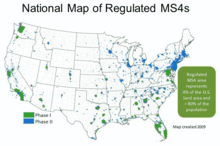
In the United States, the Environmental Protection Agency (EPA) is charged with regulating stormwater pursuant to the Clean Water Act (CWA).[25] The goal of the CWA is to restore all "Waters of the United States" to their "fishable" and "swimmable" conditions. Point source discharges, which originate mostly from municipal wastewater (sewage) and industrial wastewater discharges, have been regulated since enactment of the CWA in 1972. Pollutant loadings from these sources are tightly controlled through the issuance of National Pollution Discharge Elimination System (NPDES) permits. However, despite these controls, thousands of water bodies in the U.S. remain classified as "impaired," meaning that they contain pollutants at levels higher than is considered safe by EPA for the intended beneficial uses of the water. Much of this impairment is due to polluted runoff, generally in urbanized watersheds (in other US watersheds, agricultural pollution is a major source).[26]:15
To address the nationwide problem of stormwater pollution, Congress broadened the CWA definition of "point source" in 1987 to include industrial stormwater discharges and Municipal Separate Storm Sewer Systems ("MS4"). These facilities are required to obtain NPDES permits.[27] In 2017, about 855 large municipal systems (serving populations of 100,000 or more), and 6,695 small systems are regulated by the permit system.[28]
State and local requirements
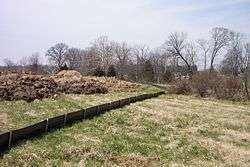
EPA has authorized 47 states to issue NPDES permits.[29] In addition to implementing the NPDES requirements, many states and local governments have enacted their own stormwater management laws and ordinances, and some have published stormwater treatment design manuals.[20][30] Some of these state and local requirements have expanded coverage beyond the federal requirements. For example, the State of Maryland requires erosion and sediment controls on construction sites of 5,000 sq ft (460 m2) or more.[31] It is not uncommon for state agencies to revise their requirements and impose them upon counties and cities; daily fines ranging as high as $25,000 can be imposed for failure to modify their local stormwater permitting for construction sites, for instance.
Nonpoint source pollution management
Agricultural runoff (except for concentrated animal feeding operations, or "CAFO") is classified as nonpoint source pollution under the CWA. It is not included in the CWA definition of "point source" and therefore not subject to NPDES permit requirements. The 1987 CWA amendments established a non-regulatory program at EPA for nonpoint source pollution management consisting of research and demonstration projects.[32] Related programs are conducted by the Natural Resources Conservation Service (NRCS) in the U.S. Department of Agriculture.

Public education campaigns
Education is a key component of stormwater management. A number of agencies and organizations have launched campaigns to teach the public about stormwater pollution, and how they can contribute to solving it. Thousands of local governments in the U.S. have developed education programs as required by their NPDES stormwater permits.[33]
One example of a local educational program is that of the West Michigan Environmental Action Council (WMEAC), which has coined the term Hydrofilth to describe stormwater pollution,[34] as part of its "15 to the River" campaign. (During a rain storm, it may take only 15 minutes for contaminated runoff in Grand Rapids, Michigan to reach the Grand River.)[35] Its outreach activities include a rain barrel distribution program and materials for homeowners on installing rain gardens.[36]
Other public education campaigns highlight the importance of green infrastructure in slowing down and treating stormwater runoff. DuPage County Stormwater Management launched the "Love Blue. Live Green." outreach campaign on social media sites to educate the public on green infrastructure and other best management practices for stormwater runoff.[37] Articles, websites, pictures, videos and other media are disseminated to the public through this campaign.
History
Since humans began living in concentrated village or urban settings, stormwater runoff has been an issue. During the Bronze Age, housing took a more concentrated form, and impervious surfaces emerged as a factor in the design of early human settlements. Some of the early incorporation of stormwater engineering is evidenced in Ancient Greece.[38]
A specific example of an early stormwater runoff system design is found in the archaeological recovery at Minoan Phaistos on Crete.[39]
See also
- Nationwide Urban Runoff Program (U.S. research program)
- Sanitary sewer overflow
- Stochastic Empirical Loading and Dilution Model
References
- Schueler, Thomas R. "The Importance of Imperviousness." Archived 2014-03-27 at the Wayback Machine Reprinted in The Practice of Watershed Protection. 2000. Center for Watershed Protection, Ellicott City, MD.
- Metcalf, Leonard; Eddy, Harrison P. (1916). American Sewerage Practice: Disposal of Sewage. III. New York: McGraw-Hill. p. 154.
- Alex Maestre and Robert Pitt; Center for Watershed Protection (2005)."The National Stormwater Quality Database, Version 1.1: A Compilation and Analysis of NPDES Stormwater Monitoring Information." Report prepared for U.S. Environmental Protection Agency (EPA), Washington, DC. September 4, 2005.
- "Runoff: Surface and Overland Water Runoff". www.usgs.gov. Retrieved 2019-08-15.
- U.S. Environmental Protection Agency, Washington, DC. "Results of the Nationwide Urban Runoff Program: Volume 1 – Final Report", Water Planning Division. 1983.
- Washington State Department of Ecology. "Control of Toxic Chemicals in Puget Sound, Phase 2: Development of Simple Numerical Models" Archived 2017-03-02 at the Wayback Machine, 2008
- "Underground Injection Control (UIC) Stormwater Drainage Wells"
-

-

- 42 U.S.C. § 300h(b)(1)(B)
- Indoor Air Quality (IAQ) Scientific Findings Resource Bank (IAQ-SFRB), "Health Risks or Dampness or Mold in Houses" "Archived copy". Archived from the original on 2013-10-04. Retrieved 2013-09-17.CS1 maint: archived copy as title (link)
- The Prevalence and Cost of Urban Flooding. Chicago: Center for Neighborhood Technology, 2013. http://www.cnt.org/media/CNT_PrevalenceAndCostOfUrbanFlooding.pdf
- "Protecting Your Businesses". Washington, D.C.: U.S. Federal Emergency Management Agency. 2015-04-22.
- Parliamentary Office of Science and Technology, London, UK. "Urban Flooding." Postnote 289, July 2007 http://www.parliament.uk/documents/post/postpn289.pdf
- The Prevalence and Cost of Urban Flooding. Rep. Chicago: Center for Neighborhood Technology, 2013 http://www.cnt.org/media/CNT_PrevalenceAndCostOfUrbanFlooding.pdf
- "Honor Award: Brays Bayou Greenway Framework, Houston, Texas". 2009 Professional Awards. Washington, D.C.: American Society of Landscape Architects. 2009. Retrieved 2018-06-08.
- Kambesis, P., R. Brucker, T. Waltham, F. Bell, and M. Culshaw. "Collapse sinkhole at Dishman Lane, Kentucky." Sinkholes and Subsidence: Karst and Cavernous Rocks in Engineering and Construction. Springer, Berlin (2005): 277-282.
- Palmer, Arthur N."Groundwater processes in karst terranes." Ground water geomorphology (1990): 177-209.
- Veni, George. Living with Karst. American Geological Institute, 2001.
- Washington State Department of Ecology (2005). Olympia, WA. "Stormwater Management Manual for Western Washington." Archived 2012-04-02 at the Wayback Machine Publication No. 05-10-029.
- National Research Council, Committee on Reducing Stormwater Discharge Contributions to Water Pollution (2009). "5. Stormwater Management Approaches". Urban Stormwater Management in the United States. Washington, D.C.: National Academies Press. ISBN 978-0-309-12540-6.
- Debo, Tom; Reese, Andrew (2003). "Chapter 2. Stormwater Management Programs". Municipal Stormwater Management. Boca Raton, FL: CRC Press. ISBN 1-56670-584-3.
- Prince George's County, Maryland. Department of Environmental Resources (January 2000). Low-Impact Development Design Strategies, An Integrated Design Approach (Report). EPA. EPA 841-B-00-003.
- "Water Sensitive Urban Design - Melbourne Water". Wsud.melbournewater.com.au. Retrieved 2011-12-05.
- United States. Federal Water Pollution Control Amendments of 1972 ("Clean Water Act"). Pub.L. 92–500, October 18, 1972.
- National Water Quality Inventory: Report to Congress; 2004 Reporting Cycle (Report). EPA. January 2009. EPA 841-R-08-001.
- United States. Water Quality Act of 1987, Pub.L. 100–4, February 4, 1987. Added CWA section 402(p), 33 U.S.C. § 1342(p).
- "Overview". NPDES / Stormwater Discharges from Municipal Sources. EPA. 2017-07-21.
- "NPDES State Program Information". National Pollutant Discharge Elimination System. EPA. 2018-08-20.
- Maryland Stormwater Design Manual (Report). Baltimore, MD: Maryland Department of the Environment. 2009. Archived from the original on 2016-02-07.
- State of Maryland. Code of Maryland Regulations (COMAR). Activities for Which Approved Erosion and Sediment Control Plans are Required. Sec. 26.17.01.05.
- Clean Water Act sec. 319, 33 U.S.C. § 1329.
- "Developing an MS4 Program". NPDES/Stormwater Discharges from Municipal Sources. EPA. 2016.
- West Michigan Environmental Action Council (WMEAC), Grand Rapids, MI. "Stop Hydrofilth." Accessed 2013-08-26.
- WMEAC. "15 to the River" Accessed 2013-08-26.
- WMEAC. "Rain Gardens... beautiful solutions for water pollution." Accessed 2013-08-26.
- DuPage County Stormwater Management. "Education and Outreach." Accessed 2013-12-27.
- Trimble, Stanley W. (2007). Encyclopedia of Water Science. Boca Raton, FL: CRC Press. ISBN 0-8493-9627-1.
- C. Michael Hogan, "Phaistos Fieldnotes." The Modern Antiquarian (2007).
External links
- Stormwater at Curlie
- EPA Stormwater Permit Program
- Stormwater Model USGS Stochastic Empirical Loading and Dilution Model (SELDM)
- Stormwater Model USEPA Storm Water Management Model (SWMM)
- International Stormwater Best Management Practices (BMP) Database
- Stormwater YouTube Page

